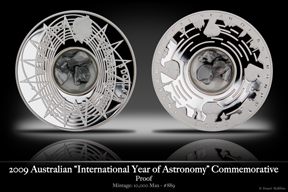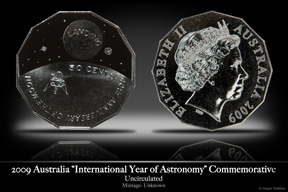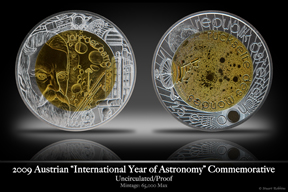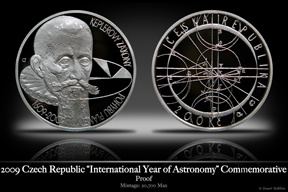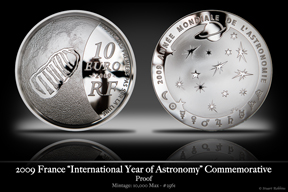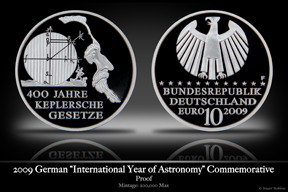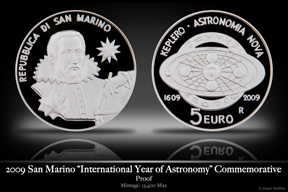International Year of Astronomy Coins (2009)
Overview
The UN passed a referendum (or whatever they pass) to make 2009 the International Year of Astronomy (IYA), in commemoration of the 400th anniversary of when Galileo turned the telescope to the sky. Among many real, worthwhile events, several countries from around the world chose to honor IYA with special coins.
Seeing that I'm an astronomer, I of course had to collect as many as I could reasonably afford, much to the detriment of my piggy bank. So far, I have collected coins from Australia, Austria, Canada, Czech Republic, France, Germany, Italy, San Marino, Ukraine, and Vatican City. Other countries have produced some coins for IYA, but I am only showing the ones that I have, below, in alphabetical order of the country of issue.
Among the coins that were issued for IYA (as in not just random astronomy coins) that I do not have:
- Australia - Australia issued two additional coins, an AU$1 and AU20¢ that was issued in mint and proof sets. The $1 featured the Parkes radio telescope in New South Wales and the 20¢ "Stargazers" featured a group sitting on the ground looking at the sky as represented by a star chart. The $1 was available in proof only in the full proof set ($92USD) while it was available in BU in a $12USD 2-coin set. The 20¢ "Stargazers" was only available in a 2-coin proof set, ($36USD) or the full Australian 2009 uncirculated set ($24USD).
- Greece - The €10 greek commemorative coin for IYA was only issued (as far as I can tell) in their mint year sets, which retail for around $95 each and I didn't really want to buy the entire set. The reverse features a stylized galaxy and stars.
- Malaysia - Malaysia issued a commemorative in several metals that showed the IYA logo on one side and the lunar lander on the other, along with the constellation Orion (I think) and the planet Saturn.
- San Marino - Besides the San Marino coin I show below, they also issued a coin in their BU mint set, but like the greek coin it is not available elsewhere and the set retailed for around $90.
- Ukraine - Ukraine also had a 1 kilogram silver commemorative that had a different design.
Australia's Contributions (That I Own)
Australia's first coin is one of my favorite of the bunch, due probably to both its simplicity and to it's "looking forward" idea (in my opinion). The reverse side of the coin is the standard Queen Elizabeth II.
The important side, however, shows a giant radio telescope dish on the bottom. Standing on it are two children, a boy and a girl, with the boy standing and the girl looking through a modern telescope that many amateurs may have (as in not an observatory-grade nor -size). Above the telescope, however, is a colorized sky with thee belt-to-sword region of the Orion constellation, showing the Orion Nebula (M42), the Running Man Nebula (M43), the Horsehead Nebula, and the Flame Nebula. It also has stylized stars towards the upper right that represent the Southern Cross. And then of course there's the "INTERNATIONAL YEAR OF ASTRONOMY 2009" text along the upper left edge.
It's a beautiful coin - if expensive - and limited to only 7,500 pieces. It is a 1-oz 99.9% silver coin with a face value of AU$1. It has a mint mark "P" and was manufactured by the Perth Mint.
Australia's second coin is one that's grown on me, and it also represents the very first piece of meteorite that I own (which is odd, considering that I'm an astronomer). I'm also experimenting with intentionally adding a white glare in the cameo part of the fields. This is partly a requisite due to the ginormous size of the coin, but also because it's how many illustrations from the world mints depict the coin.
The reverse contains a mini-portrait of Queen Elizabeth II, but the main part of the design is a stylized solar system with 8 planets (plus Earth's moon) and Pluto on pseudo-representative orbits about the center. It also contains the Queen's name, the country, the 2009 date, and the AU$5 nominal face value.
The obverse is more interesting and works well with the "looking forward" theme of the radio telescope above, and is more a "looking upwards," or, "everyone around the world can enjoy the skies." The largest visual elements are four faces around the coin looking upwards towards the center of the coin, while the field of the coin contains streaks meant to be star trails. Smaller, around the edge, lie 16 of the world's famous landmarks. Starting at the 12:00 position and moving clockwise, I have tried to identify them: Pyramids at Giza, [??], Taj Mahal in India, a mountain - possibly Mt. Fuji in Japan, [??], Sydney Opera House, [??], Radio Telescope (not sure where, they kinda all look alike), Heads at Easter Island, Machu Pichu in Peru, Golden Gate Bridge in San Francisco USA, Statue of Liberty in New York USA, Stone Henge in England, Leaning Tower of Pisa in Italy, Eiffel Tower in France, [??]. If anyone knows something I got wrong or what the [??] are, let me know!
Finally, the center of the coin contains a plastic "blister pack" that has 5 small pieces of an iron-nickel meteorite. I could not find out what meteorite they were from other than a vague mention of "Wolf Creek crater image courtesy of ..." but I think they mean "meteorite" instead of "crater."
It's a nice coin and an expensive one at AU$125 or so, and it is limited to only 10,000 pieces. It is a 50-gm 99.9% silver coin with a face value of AU$5. It's a big coin.
Yet another Australian coin I have for this year is a 50¢ 12-sided uncirculated coin that commemorates the 40th anniversary of the US' moon landings (Apollo 11). It is a very dark coin and was very difficult to photograph.
Austria's Contribution
Austria's coin is pretty neat, but it's really busy. I think it tried to do a bit too much, though they did it better than Italy.
The obverse of the coin has, as the niobium center, one of Galileo Galilei's original sketches of the lunar surface. Prominently featured to the bottom left of the coin is Galileo himself. To his lower right is a rendition of his original telescope. Then, following along the edge of the coin counter-clockwise, we see a modern reflector (mirror) telescope that anyone can buy for a few $hundred, a modern observatory, a radio telescope, then Saturn (Galileo was the first to view Saturn's rings), the sun, and finally a space telescope (I think Hubble is actually pictured). The double-date 2009 is at the top paired with 1609 at the bottom.
If that wasn't enough ... the reverse of the coin features the lunar far side that humans had never glimpsed until the Soviets flew by in the early 1960s. I think it's a fitting flip to Galileo's sketch of the near side on the obverse. The reverse also features Earth behind the moon, a satellite, and the stylized sun. It also bears the denomination of the coin and "republik österreich," which I'm pretty sure means the "Republic of Austria."
The coin has a face value of €25 and is 90.0% silver. It has a maximum mintage of 65,000 pieces. It is pretty interesting in that the core of the coin is gold-colored, but it is not gold. It is niobium, an interesting metal to use in coins because it can be made into many different colors just based upon the temperature to which it is heated.
Canada's Contribution
Canada's coin for IYA is fairly nice, and it's reasonably simplistic. It's also another of the colorized ones.
The standard reverse of the Queen Elizabeth II portrait forms the more boring side.
The obverse of the coin is pretty neat. It shows a modern observatory with a little path leading up to it, surrounded by trees. The four gas giants of the solar system (Jupiter, Saturn, Uranus, Neptune) are shown in the "sky" along with a center colored image of a spiral galaxy and comet.
The coin has a face value of $30 Canadian and is 92.5% silver (sterling silver). It has a maximum mintage of 10,000 pieces.
Czech Republic's Contribution
The Czech Republic's coin came very late in 2009 and is yet another to honor Johannas Kepler and the formulation of his Three Laws of Planetary Motion that we still use today. They're kinda on the level of Newton's Laws of Motion for astronomy.
The obverse (or face ... not sure it's actually the obverse) shows Kepler along with a representation of his Second Law which effectively states that a planet will sweep out equal area in equal time (when it's closer to the sun, it will move faster in its orbit).
The reverse is really quite complex. I honestly don't quite know what it's supposed to represent, but it could be some rendition of Kepler's diagrams that he used to figure out his basic planetary laws. I don't think it's an astrolabe as was featured on many other IYA coins. It also contains the denomination, 200 Kč (200 CZK), and the mint mark for Česká Mincovna, the "C" with the bar over it and an inset capital "M" (I can't find a symbol for it on my computer).
With a face value of 200 Kč (koruna), the coin has a face value of around $10.50 USD (as of January 2010). This is actually quite a lot considering the coin is only 13 gms and 90% silver (balance copper). There is edge lettering on the proof version (which is what I have) that reads, "ČESKÁ NÁRODNÍ BANKA * Ag 0.900 * 13 g *" which translates as the "Czech National Bank" and then the fraction of silver and total weight. An uncirculated version with a limit of 10,700 pieces was also minted.
France's Contribution
France's coin for IYA is an interesting piece and my only coin that's not, well, flat. The coin is domed, and hence is a bear to photograph, where the convex (upwards in the middle) side is what I've selected as the obverse, and concave is the reverse. What you may be barely able to make, out of focus, is actually me, my camera, and tripod above the coin but way out of focus.
The obverse commemorates the 40th anniversary of the Apollo 11 moon landing. It shows the moon with a boot print over about 70% of the surface and then the denomination, year, and mint next to it. In addition, there are two small privy marks on either side of the date, one a cornucopia, and the other appears to be a dove.
The reverse is elegant in its simplicity, emphasizing the dome of the sky with stylized stars over it and the planet Saturn at the top. Around the bottom are the astronomical symbols of the planets, starting with the moon ☾, then sun, and then going through Mercury, Venus, Mars, Jupiter, Saturn, Uranus, Neptune, and Pluto. Interestingly, Earth is missing, and the symbol for Pluto is not the standard one that's used in astronomy (♇).
What's really cool about this coin is the 1 ounce gold version. Picture the coin above, in gold, but then with the matte "sky" section on the reverse plated in blue gold. Purdy. Too bad the sucker retails for around $2000.
The coin has a face value of €10 and is 90% silver, weighing in at 22.2 gm with a diameter of 37 mm. It has a maximum mintage of 10,000 pieces. The coin was also available in a 500-mintage 163.8 gm (5.77 oz) version, a 1000-mintage 8.45 gm (0.30 oz) gold one, and then the 1000-mintage 31.104 gm (1.1 oz) gold with blue gold plate version.
Germany's Contribution
Germany's coin is very simple compared with most of the others. Besides the standard German eagle, the other side of the coin is simple in its design yet very important in what it represents.
Johannas Kepler was a scientist in the 17th century who poured over tables upon tables of data on the positions of planets as recorded by his then-deceased mentor, Tycho Brahe. It was from studying these that Kepler derived his three imperial Laws of Planetary Motion. The first law states that planets travel in ellipses. The second is that planets will sweep out equal area in equal time -- in other words, it will move faster the closer it is to the large (somewhat)-central mass that dominates its orbit (e.g. the sun). Third is effectively P2~r3, where P is the period (year) of the orbit, and r is the distance from the primary (somewhat)-central mass.
Anyway ... this coin features Kepler in profile along with a diagram of an ellipse, illustrating the derivation of his Laws. Simple, yet important and something that represented a paradigm shift at the time.
The coin is a silver proof. It has a face value of €10. There is a mintage limit of 200,000 on the proof version.
Italy's Contribution
I think the obverse of Italy's coin is beautiful, but the reverse is simply too cluttered.
The obverse of the coin shows a representation of Liberty in profile. To her right, she is looking at stylized stars. To her left, there is an astrolabe depicted, which is an instrument that had been used to predict the motions/positions of the planets and stars.
The reverse is much more complicated. The main feature that splits the coin in half on a diagonal is a rendition of Galileo's telescope (also featured on Austria's coin, above). The top motif above the telescope is another astrolabe. Below are several constellations. I recognized Leo, Böotes, Corona Borealis, and Cygnus, but there are several others that I couldn't quite figure out what they were. The denomination of €10 is on there, along with "ASTRONOMIA ANNO INTERNAZIONALE" ("International Year of Astronomy").
The coin is a 92.5% silver proof coin with a 34mm diameter that weighs 22 gms. It has a mintage limit of only 9,000 pieces.
San Marino's Contribution (That I Own)
San Marino's coin honors Kepler along with Germany's. I also like it for its simplicity when compared with some of the others.
The reverse bears the image of Johannas Kepler, along with the issuing country, "REPUBLICA DI SAN MARINO." Kepler is shown using a compass on a globe. Two stylized stars also adorn the obverse.
The obverse is perhaps more interesting. It bears Kepler's name (KEPLERO) along with the book he published, "New Astronomy" (or, "ASTRONOMIA NOVA"). It bears the sun at the center of a system with 8 planets, as Kepler was instrumental in advancing the heliocentric model of the solar system. Surrounding the system are the 12 signs of the Western/Greek Zodiac: ♈ (Aries), ♉ (Taurus), ♊ (Gemini), ♋ (Cancer), ♌ (Leo), ♍ (Virgo), ♎(Libra), ♏ (Scorpio), ♑ (Capricorn), ♒ (Aquarius), ♓ (Pisces).
The coin is different from the others in that it is not struck by its issuing nation, rather it was struck by the Italian mint for San Marino (and bears the large "R" mint mark as does Italy's coin on the reverse). The coin is limited to only 13,400 pieces (not sure how they arrived on that number). It is a 18-gm 92.5% silver (sterling silver) coin with a face value of €5.
Ukraine's Contribution (That I Have)
Getting ahold of the Ukraine IYA coin was somewhat difficult and wasn't findable until very late in the year, not even being issued until October. A 1 kg coin was released earlier, but a kilo of silver is a bit beyond my price level (1 kg ≈ 32 oz silver).
The obverse of the coin illustrates Urania, the patroness of astronomy, one of the nine muses in Greek mythology. The rest is meant to symbolize the heavens. It also contains the Ukraine coat of arms and text that translates to "National Bank of Ukraine." It also has the denomination.
The reverse is the portrait of Russian philosopher, astrologist, writer, and doctor, Yuriy Drohobych (translitterated). To the left shows the IYA logo, and the bottom half a desk with just a bunch of, well, stuff.
The coin is limited to only 45,000 pieces. It is a 16.54-gm cupronickel coin that's in a not very good proof condition (probably would not earn a deep/ultra cameo designation from PCGS/NGC. The face value is 5 Hryvnia (not sure how to pronounce that).
Vatican City's Contribution
To anyone who knows pretty much anything about the history of astronomy, the idea of the Vatican producing a coin commemorating the International Year of Astronomy may seem a bit odd. I know I thought it was. I was also very hesitant to purchase it -- mostly due to its cost of nearly $100 for a simple €2 coin, and an uncirculated quality one at that. But, my OCDness won out.
The obverse of this coin is uninteresting as it is the standard €2 obverse.
The reverse is more interesting, and I'm actually not entirely certain what it depicts. First, the nickel outside part has 12 stars, presumably for the 12 original Eurozone nations. The text is "CITTA' DEL VATICANO" (Vatican City) and "ANNO INTERNAZIONALE DELL' ASTRONOMIA" (International Year of Astronomy). I'm assuming the language is Italian and not Latin, but I'm too lazy at the moment to check.
Inside this are four panels. Obviously the one in the upper right quadrant is supposed to depict the Judeo-Christian God. The one next to it is Galileo's telescope, while the one in the lower right panel is a Newtonian reflectig telescope that many amateur astronomers are likely familiar with. The lower left quadrant is ... something. I have no idea what. And below it includes the sun, moon, three stars, and presumably three planets, along with the year. The mint mark "R" I believe refers to the Italian mint, following San Marino's idea of not having its own "country" strike its coin.
The coin is limited to only 106,084 pieces (really not sure how they arrived on that number). It is a 8.5-gm bimetallic coin with an outer cupronickel ring (75% copper, 25% nickel) and nickel brass center (75% copper, 20% zinc, and 5% nickel) with a face value of €2.

